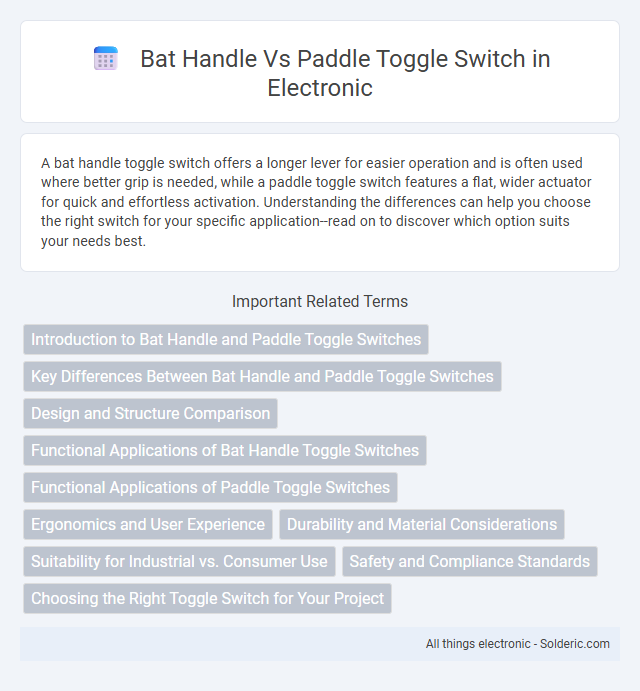A bat handle toggle switch offers a longer lever for easier operation and is often used where better grip is needed, while a paddle toggle switch features a flat, wider actuator for quick and effortless activation. Understanding the differences can help you choose the right switch for your specific application--read on to discover which option suits your needs best.
Comparison Table
| Feature | Bat Handle Switch | Paddle Toggle Switch |
|---|---|---|
| Design | Lever-style handle, elongated shape | Flat, wide paddle-shaped toggle |
| Operation | Push or pull for switching | Rocker movement, tilt to switch |
| Applications | Industrial machinery, heavy-duty controls | Consumer electronics, appliances |
| Durability | High mechanical strength | Moderate mechanical strength |
| Installation | Requires robust panel mounting | Easy snap-in or screw mounting |
| Switching Speed | Slow to medium | Fast, responsive toggling |
| Size | Generally larger | Compact size |
| Cost | Higher due to heavy-duty parts | Lower; cost-effective |
Introduction to Bat Handle and Paddle Toggle Switches
Bat handle and paddle toggle switches are two common types of electrical switch actuators used in various industrial and commercial applications. Bat handle switches feature a slender, elongated lever that provides high leverage for quick on/off operation, often used in motor control circuits. Paddle toggle switches, characterized by a wider, flat actuator, offer enhanced tactile feedback and ergonomic design, making them suitable for frequent switching with improved user control.
Key Differences Between Bat Handle and Paddle Toggle Switches
Key differences between bat handle and paddle toggle switches include their design and operation mechanisms, where bat handle switches feature a slim, elongated lever for precise control, while paddle switches use a broad, flat actuator for easier activation. Bat handle switches are often preferred for industrial applications requiring high durability and a distinct tactile response, whereas paddle switches enhance ergonomics and accessibility, making them ideal for environments needing quick and effortless toggling. Understanding these distinctions helps you select the appropriate switch type tailored to your specific functional and ergonomic requirements.
Design and Structure Comparison
Bat handles feature a long, smooth lever designed for quick, easy toggling with a flat or slightly rounded surface for comfortable grip and visibility in industrial settings. Paddle toggle switches have a broader, flatter actuator with a paddle-like shape, enhancing ergonomic control and making them suitable for applications requiring precise, tactile feedback. Your choice between bat handles and paddle toggles depends on the need for rapid operation versus fine control, with design and structure tailored to specific user interaction and environmental demands.
Functional Applications of Bat Handle Toggle Switches
Bat handle toggle switches are widely used in industrial machinery and heavy equipment for their robust design and ease of operation, providing reliable control over high-current circuits. These switches are ideal for environments requiring quick manual activation or deactivation of power, such as automotive controls, power tools, and heavy-duty electrical panels. Their ergonomic design enhances user safety and operational efficiency, particularly in harsh or high-vibration conditions.
Functional Applications of Paddle Toggle Switches
Paddle toggle switches offer ergonomic designs that facilitate quick and easy operation, making them ideal for high-frequency use in industrial machinery and automotive dashboards. Their large surface area provides better grip and tactile feedback, enhancing safety and precision in control panels and heavy equipment. These switches are commonly employed in applications requiring rapid toggling and reliable on/off functionality under harsh conditions.
Ergonomics and User Experience
The bat handle toggle switch offers a larger grip surface, enhancing comfort and reducing finger strain during repeated use, making it ideal for applications requiring frequent switching. In contrast, the paddle toggle switch features a flatter, wider actuator that allows for easy thumb or palm actuation, improving control and precision in tight spaces. Both designs prioritize tactile feedback, but bat handles excel in ergonomic handling while paddle toggles optimize accessibility and user interface efficiency.
Durability and Material Considerations
Bat handle switches typically feature robust construction with metal or high-impact plastic materials that provide enhanced durability for heavy-duty applications. Paddle toggle switches often utilize reinforced plastic or aluminum components, balancing strength with ergonomic design for frequent use. Material selection influences resistance to wear and environmental factors, making bat handle switches preferable in industrial settings while paddle toggles excel in commercial or residential environments.
Suitability for Industrial vs. Consumer Use
Bat handle switches are highly durable and designed for industrial applications where robust performance and resistance to harsh environments are essential. Paddle toggle switches offer ease of use and aesthetic appeal, making them more suitable for consumer electronics and light-duty applications. Choosing the right switch depends on Your need for durability and environment conditions, with bat handle switches excelling in industrial settings and paddle toggles preferred in consumer products.
Safety and Compliance Standards
Bat handles and paddle toggle switches both adhere to strict Safety and Compliance Standards, often meeting UL, IEC, and CSA certifications to ensure reliable performance in electrical applications. Bat handles provide enhanced insulation and are frequently preferred in industrial environments where higher voltage isolation and operator safety are critical. Your choice should consider the specific application requirements, as paddle toggle switches may offer easier operation but typically require additional protective measures to meet equivalent safety standards.
Choosing the Right Toggle Switch for Your Project
Selecting the right toggle switch, such as a bat handle or paddle type, depends on the specific application requirements including load capacity, space constraints, and user ergonomics. Bat handle switches offer a rugged design ideal for heavy-duty industrial environments where durability and a secure grip are essential, while paddle toggle switches provide a low-profile, streamlined option suited for control panels requiring quick and easy operation. Evaluating factors like voltage rating, actuator size, and mounting options ensures optimal functionality and longevity in your project.
bat handle vs paddle toggle switch Infographic

 solderic.com
solderic.com